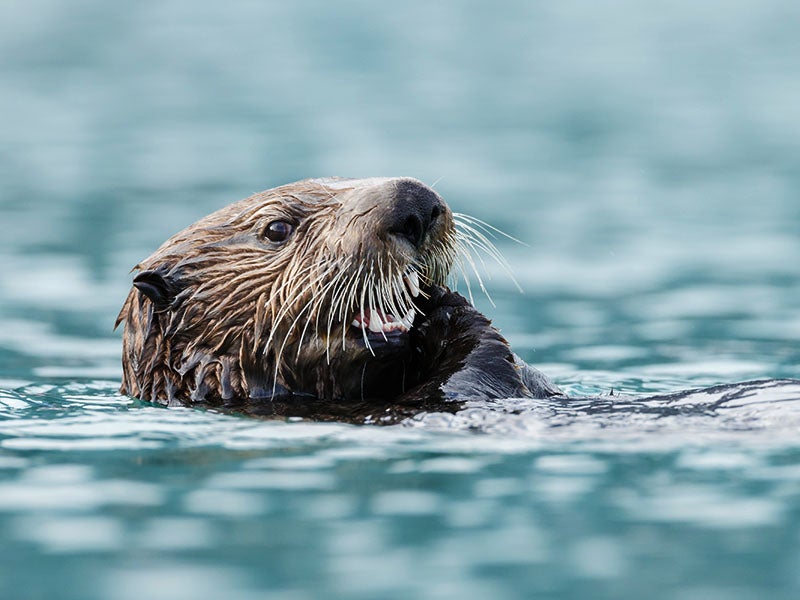Judges Agree: They Otter Be Free
Fishing industry groups wanted to revive a harmful program that excluded otters from parts of their coastal habitat—but Earthjustice fought back.

This page was published 6 years ago. Find the latest on Earthjustice’s work.
California sea otters can keep swimming toward a full recovery. Last fall, the Supreme Court declined to review a decision that boosts the otters’ chances of expanding their population.
Fishing industry groups sued the U.S. Fish and Wildlife Service in hopes of reviving an ill-advised program known as the “No Otter Zone,” which was supposed to exclude the already threatened otters from parts of their historic range along the California coast.
Earthjustice intervened in the case on behalf of the marine mammals, and three federal courts confirmed the government’s decision to end the No Otter Zone. When opponents of otter protection asked the Supreme Court to reconsider the lower court decision, Earthjustice opposed the request. The Supreme Court’s decision marks the end of years of litigation.
Earlier in 2018, the Ninth Circuit Court of Appeals emphasized that the illogical nature of the industry groups’ reading of the law “would turn a statute aimed at preservation of the otter population into one that impedes that goal where the experimental population does not thrive” and that requiring the service to harm the very species it meant to protect “would make no sense whatsoever.”
“This decision marks an important milestone that promotes the otter’s well-being and hopefully puts an end to further, misguided attempts to revive the failed No Otter Zone program,” says Earthjustice attorney Andrea Treece.
Sea otters are a keystone species—the lynchpin of ecosystems. When otters feed on shellfish, particularly sea urchins, they control the population of these species. Otherwise, urchins could consume all of the giant seaweed, or kelp, in the otter’s coastal habitat. Besides protecting coastal areas from storm surges, kelp is also beneficial as a major source of food and shelter for other organisms. Certain crabs and abalone depend on kelp for food, while many types of fish use kelp forests to hide from predators. Sea lions and seals feed on the fish that live in the kelp forests, and grey whales have even been observed in these kelp safe havens, most likely hiding from predatory killer whales. Without sea otters to keep sea urchin numbers in check, the entire ecosystem could collapse.
As well as being the glue that holds coastal ecosystems together, otters also help mitigate the effects of climate change. Atmospheric CO2 concentrations have increased by 40 percent since the start of the industrial revolution, causing global temperatures to increase. Removing CO2 from the atmosphere can help reduce the rate of this global warming. The kelp forests otters protect are carbon-sequestering powerhouses; the kelp plants absorb large amounts of CO2 from the atmosphere during photosynthesis. According to a 2012 study, healthy, otter-protected kelp forests can absorb up to 12 times more CO2 than unprotected kelp.
That’s why Earthjustice is vigorously defending sea otter recovery efforts and working to put the ill-conceived “No Otter Zone” firmly in the past, where it belongs. The “No Otter Zone” was part of a Fish and Wildlife Service program, started in the late 1980s, to translocate sea otters to a new offshore island habitat, while also keeping them out of Southern California waters where they had historically lived in order to appease commercial fishing groups. In the early 2000s, the Fish and Wildlife Service concluded repeatedly that the “No Otter Zone” was preventing otters from expanding their natural range, which the otters must be able to do in order to recover as a species.
In 2013, the service finally determined that the translocation program had failed, harming more otters than it helped, but shellfish harvesters challenged the decision in two separate lawsuits. Earthjustice intervened in both cases, and in September 2015, a federal district court judge ruled that the agency was right to end the otter exclusion. The agency’s decision was later upheld by another federal district court judge as well as the Ninth Circuit.
A robust sea otter population helps everyone. Fishermen benefit from healthy fish nurseries and coastal ecosystems, neighborhoods benefit from a natural barrier against storm surges and sea level rise and the planet benefits from reduced levels of atmospheric CO2. Protecting sea otters is a no-brainer—it’s in our best interests to make sure these threatened mammals reap the full benefits of federal protection.
This blog post was originally published in March 2017. It was updated May 29, 2019.
Earthjustice’s Oceans Program uses the power of the law to safeguard imperiled marine life, reform fisheries management, stop the expansion of offshore oil and gas drilling, and increase the resiliency of ocean ecosystems to climate change.